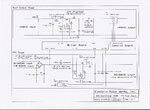T
treez
Guest

Yes, anyway I definetely think that there is some situation with mains connected Switch Mode Power Supplies, whereby they can become “victim” of the terrors of the mains, be that transients or whatever.
I think that this affliction more concerns those switching supplies which also have an Earth connection.
Very little is publicly known about this, because obviously those companies who know much about it guard it closely as their intelligent product, -their little “earner”.
I remember when I worked at the electric drives place described above, the “reason for failures” document was an absolute top secret document, and no-one was even allowed to discuss it. It was strange because we had an entire section of engineers repairing and diagnosing blown drives, and yet, if any member of staff ever asked about drive failures, they were always told “We have a zero failure rate!”. –Which was strange being told that when you could see the large “repair section” working all day long.
So yes, I believe that it is totally pointless designing and marketing high power single stage Electric vehicle chargers which are expensive to do. –Just do an Electric vehicle charger as a load of low power, filthy cheap, paralleled modules.
I think that this affliction more concerns those switching supplies which also have an Earth connection.
Very little is publicly known about this, because obviously those companies who know much about it guard it closely as their intelligent product, -their little “earner”.
I remember when I worked at the electric drives place described above, the “reason for failures” document was an absolute top secret document, and no-one was even allowed to discuss it. It was strange because we had an entire section of engineers repairing and diagnosing blown drives, and yet, if any member of staff ever asked about drive failures, they were always told “We have a zero failure rate!”. –Which was strange being told that when you could see the large “repair section” working all day long.
So yes, I believe that it is totally pointless designing and marketing high power single stage Electric vehicle chargers which are expensive to do. –Just do an Electric vehicle charger as a load of low power, filthy cheap, paralleled modules.





